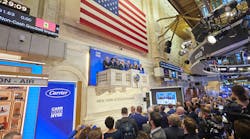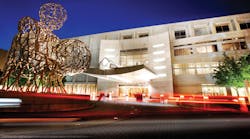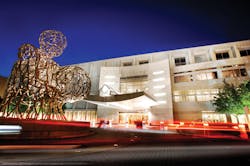At Atlanta Symphony Hall, part of the Woodruff Arts Center in Midtown Atlanta, metal cooling towers located on the roof were at the end of their useful life. Noise from air turbulence at the fans and water flowing into the collection basins would fill the concert hall midperformance and detract from patrons’ enjoyment. Steve Trott, director of engineering for the Woodruff Arts Center, likened the sound to that of a jet passing over the building.
“We knew that we had to replace (the cooling towers) soon,” Trott said. “We considered typical metal towers, stainless steel, partial stainless steel. ... We looked at cross-flow and counter-flow designs.”
On the recommendation of the Atlanta office of DLB Associates Consulting Engineers, Trott and his team then looked at cooling towers made of high-density polyethylene (HDPE).
“We found those cooling towers were very quiet and would provide the sound insulation needed without having to go to a special quiet-tower package, which would really increase the cost,” Trott said.
The HDPE design Trott’s team discovered was pioneered by Delta Cooling Towers Inc. primarily to solve problems of corrosion from soft water, salt air, caustic industrial gases, and the like that have plagued metal towers. While the dramatically extended lifespan of HDPE towers has been a major factor in their selection for years, more recently, the quietness of their operation has taken on significant importance for many applications.
Getting Rid of Decibels
With the continued development of inner cities and the closer proximity of commercial and industrial buildings to residential neighborhoods, “noise pollution” from commercial HVAC equipment is a growing concern of communities across the nation.
For example, the Franklin Institute in Philadelphia, mandated by city ordinance to restrict sound output to less than 50 dB—less than the normal noise output of a traditional cooling tower—recently replaced its cooling towers.
“They decided on HDPE cooling towers for a combination of factors,” Martin M. Previtera, regional manager for Delta Cooling Towers, said. “They were able to achieve better pricing while also meeting the dBA rating of less than 50. This is a four-cell cooling tower. They installed the same type of cooling tower at Woodruff Arts Center.”
According to Temple University’s Civil & Environmental Engineering Department, 50 dBA (A-weighted decibels, the relative loudness of sounds in air as perceived by the human ear) is equivalent to the noise in a quiet suburban home.
Other Benefits
Woodruff Arts Center selected two sets of 500-ton twin-cell TM Series towers, each featuring a 20-year warranty on corrosion or other physical damage.
Trott said the HDPE towers are providing other important benefits.
“One of the other reasons we chose these cooling towers was that they are available with direct-drive motors,” Trott explained. “That means no gearbox and no belt, which greatly improves operating reliability and reduces maintenance requirements. At the same time, it provides significant energy savings.”
Trott added the cooling towers feature variable-speed fan drives, which provide smooth operation and consistent water temperature. During the first summer of operation, the fans ran at 50-percent speed or less most of the time.
For Design Solutions author guidelines, call Scott Arnold, executive editor, at 216-931-9980, or write to him at [email protected].











